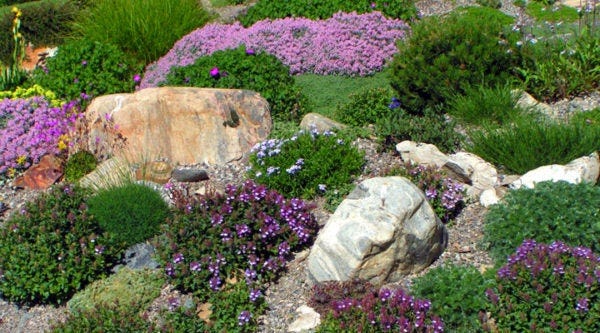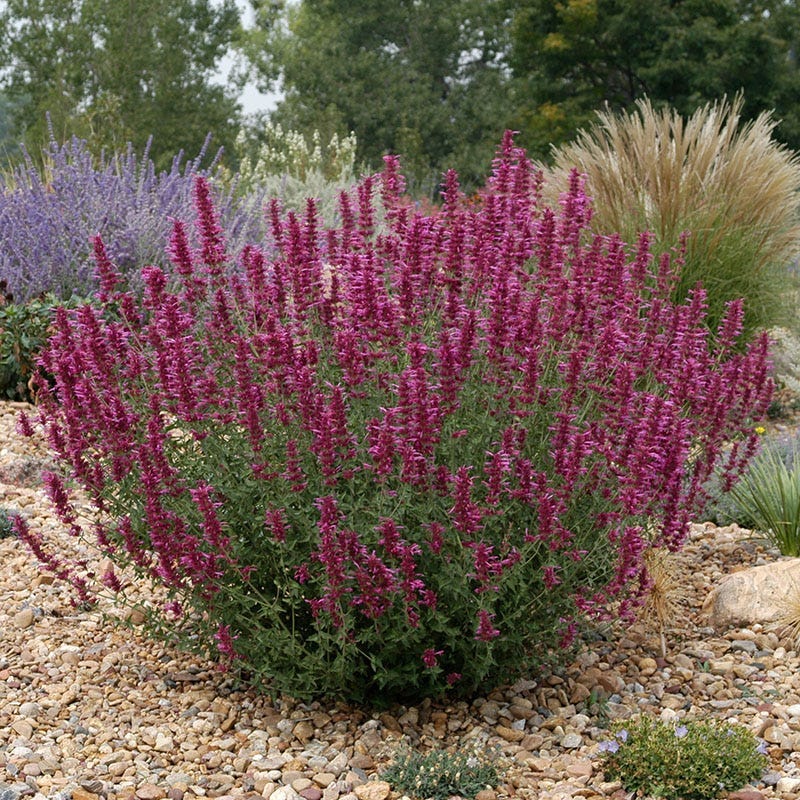-
Easy Gardening: Top 4 Tricks of the Trade

by David Salman, High Country Gardens Chief Horticulturalist
Conservation of Energy: Ideas for a More Beautiful and Labor Efficient Garden
I have to face the fact that I'm not as energetic doing garden chores and projects as I used to be. But my love of plants and gardening is stronger than ever. What's a horticulturist to do? Well, getting older has the advantage of experience. And a lifetime of gardening has taught me a few "tricks of the trade" that allow me to spend less time "doing" and more time "enjoying" when I'm outside with my plants. So whether you're getting older or just want to spend less time doing gardening chores, I have some easy gardening ideas for you to consider.
David Salman's Top 4 Ways To Do Less And Enjoy More
- Design A Low-Care Garden
- Use Mulch
- Use Reseeding Plant
- Folar Feed During The Growing Season

Catmint (Nepeta) planted in multiples makes for easier gardening and a unified look. Also featured is Columbine (Aquilegia), Oriental Poppy (Papaver orientale) and Ornamental Grasses. Photo from a customer garden.
Tip 1: Design A Low-Care Garden
If you have a big landscape to install or are just planning to plant a modest new flower bed, how you put the new garden together makes a huge difference in terms of its care and maintenance. If low maintenance is a priority, there are easy ways to design it so that you can enjoy a beautiful yard and save on labor, time and expense.
- Make small areas of concentrated color where long-blooming perennials and ornamental grasses are the focus.
- Use more of few types of plants to simplify their maintenance and maximize their visual impact.
- Use a variety of shrubs, vines and ornamental grasses to cover larger areas of the yard.
- Forgo a lawn unless you absolutely must have it.
- Use groundcovers as turf grass substitutes to provide the open feel and look provided by a lawn.
Tip 2: Use Mulch
In the western US where more arid growing conditions prevail, watering can take up an enormous amount of a gardener's time, especially if it's to be done manually with a hose and sprinkler. Water is also a precious and expensive resource requiring conservation. Mulching saves water and time spent on plant maintenance. Find the right mulch for your style of gardening and plant palette and use it consistently. Mulching is a time saver because it reduces weeding and protects your plant's roots from the summer heat. This helps to grow healthier plants that need less care.
Tip 3: Use Reseeding Plants
I have come to appreciate the natural style of gardening as an expression of how our plants interact with the weather, climate, and in the growing conditions where I live. As much as I used to enjoy gardens with large numbers of different plants and more structured, detailed designs, I have come to greatly appreciate a garden where many of the plants have, over time, spread and established themselves in new places, by propagating themselves through re-seeding. These "volunteers" (re-seeded children of the original plants) are survivors that have found places that are well suited to their needs. Consequently, they need very little care to look their best.
Some of my favorite, non-weedy naturalizing perennials:
- Beebalm (Monarda fistulosa 'Wichita Mountains')
- Blue Flax (Linum perenne 'Appar')
- Chocolate Flower (Berlandiera lyrata)
- Fame Flower (Phemeranthus calycinum)
- Globe Mallow (Sphaeralcea munroana)
- Golden Columbine (Aquilegia chrysatha),
- Arizona Columbine (A. desertorum)
- Jupiter's Beard (Centranthus ruber)
- Poppy Mallow (Callirhoe involucrata)
- Rocky Mountain Beardtongue (Penstemon strictus),
- Eaton's Firecracker Beardtongue (P. eatonii)
- Texas Hummingbird Mint (Agastache cana),
- Licorice Mint Hyssop (A. rupestris),
- New Mexico Hyssop (A. neomexicana)
- Wild Four O'Clock (Mirablis multiflora)
Tip 4: Foliar Feed During The Growing Season
Our plants can often use a gentle boost during the growing season. Foliar feeding, or feeding plants with a nutrient spray, is a real time saver. Foliar feeding with a gentle natural or organic fertilizer is a highly effective way to supplement or restore plant health during the growing season. Foliar feeding is also highly beneficial to new transplants, which can struggle as their roots grow and adjust to their new soil. It allows the gardener to fertilizer a much larger number of plants, compared to mixing and watering the plants with a fertilizer solution, or top dressing the soil with a compost/natural fertilizer mix (which is best done in the fall anyway).
How To Foliar Feed Plants:
- Mist the plant leaves thoroughly in the early morning with a mix of seaweed and fish emulsion. I use a simple 2-gallon pump sprayer or backpack sprayer, but a handheld spray bottle will work as well.
- Do this several times, two weeks apart, as needed.
